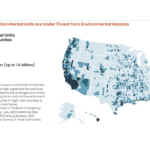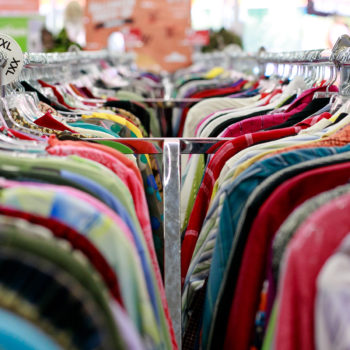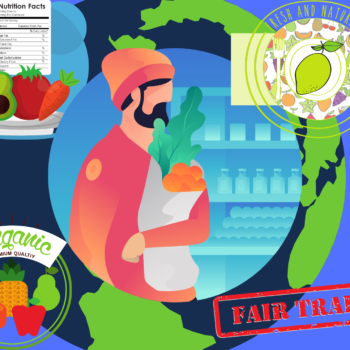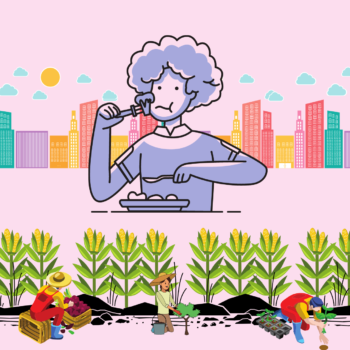|
|
In recent years, the urgency of the nature crisis has become increasingly evident. Reports from various environmental organizations, including the Intergovernmental Panel on Climate Change (IPCC) and the World Wildlife Fund (WWF), paint a stark picture of our planet’s challenges. From deforestation and species extinction to plastic pollution and global warming, the signs of environmental degradation are all around us.
However, amidst these challenges lies an opportunity for individuals to make a difference through conscious choices and lifestyle changes. Transitioning to an eco-friendly or sustainable lifestyle is not only beneficial for the planet but also for our well-being.
In this post, we’ll explore ten smart strategies for upgrading to an eco-friendly lifestyle backed by research and practical advice.
Key Takeaways
-
- The nature crisis, characterized by biodiversity loss, habitat destruction, and climate change, threatens the ecosystems sustaining life on Earth.
-
- Human activities such as deforestation, overfishing, pollution, and burning fossil fuels are identified as the biggest culprits of the nature crisis.
-
- The man-made nature crisis has apparent and adverse effects on the environment and different aspects of human society, including health and economic systems.
-
- Transitioning to an eco-friendly lifestyle involves making conscious choices that minimize environmental harm and promote sustainability.
-
- Reduce, reuse, and recycle to minimize waste and conserve natural resources.
-
- Minimize energy usage, choose sustainable transportation, and adopt a plant-based diet to reduce your carbon footprint.
-
- Support sustainable fashion, reduce food waste, and embrace minimalism to lighten your ecological footprint.
-
- Cultivate sustainable habits, practice gratitude, and reconnect with nature to foster a more profound sense of stewardship and responsibility towards the planet.
Human and the Nature Crisis
The relationship between humans and the environment has reached a critical point. The nature crisis, characterized by biodiversity loss, habitat destruction, and climate change, threatens the ecosystems sustaining life on Earth.
According to the WWF’s 2022 Living Planet Report, global populations of mammals, birds, fish, amphibians, and reptiles have declined by an average of 69% since 1970.
Another report from Conservation International noted that, as of May 2022, the amount of carbon dioxide (CO2) in our atmosphere is at its highest point ever recorded in human history.
Both reports identified human activities, such as deforestation, overfishing, pollution, and burning of fossil fuels, as the biggest culprits.
Unfortunately, this man-made nature crisis has apparent and adverse effects on the environment and different aspects of human society, including health and economic systems.
| Effects of the Nature Crisis on Human Society | Description |
|---|---|
| Health Impacts | Degradation of air, water, and soil quality leads to respiratory diseases, waterborne illnesses, exposure to toxic chemicals, and mental health issues due to the loss of natural spaces and biodiversity. |
| Economic Disruption | Disruption of livelihoods, industries, and economies dependent on ecosystem services such as agriculture, fisheries, forestry, tourism, and recreation leads to loss of income, food insecurity, poverty, and economic instability. |
| Food Security Threats | The decrease in agricultural productivity, crop failures, and biodiversity loss reduce the availability and diversity of food sources and exacerbate food shortages, malnutrition, and food price volatility, particularly in vulnerable communities. |
| Water Scarcity | Depletion and pollution of freshwater sources reduce water availability and quality, leading to water scarcity, sanitation challenges, and conflicts over water resources, affecting human health, agriculture, industry, and ecosystems. |
| Increased Vulnerability to Natural Disasters | Loss of natural buffers such as wetlands, mangroves, and forests exacerbates the impacts of natural disasters such as floods, storms, and wildfires and increases human vulnerability, displacement, and loss of lives and property. |
| Displacement and Forced Migration | Displacement of communities due to environmental degradation, habitat loss, natural disasters, and climate change leads to forced migration, conflicts over resources, loss of cultural heritage, and social tensions in receiving areas. |
| Loss of Cultural Heritage and Traditional Knowledge | Disruption and erosion of indigenous and local cultures, languages, traditions, and knowledge systems linked to the land and ecosystems lead to loss of identity, social cohesion, and resilience and diminishing cultural diversity globally. |
| Increased Social Inequality and Vulnerability | The exacerbation of social inequalities, disparities, and vulnerabilities due to unequal access to natural resources, environmental services, and opportunities amplifies socioeconomic divisions and injustices within and between communities. |
| Threats to Human Security and Stability | Environmental degradation, resource scarcity, and climate-related conflicts increase risks to human security, stability, and peace, fueling social unrest, violence, and displacement and posing challenges to governance and international relations. |
| Public Health Risks and Pandemic Vulnerability | Degradation of ecosystems and loss of biodiversity increases the risk of zoonotic diseases, emerging infectious diseases, and pandemics, highlighting the interconnectedness of human, animal, and environmental health. |
As the dominant species on the planet, humans have a profound impact on the environment. Our consumption patterns, production methods, and waste disposal contribute to environmental degradation. However, we also have the power to reverse these trends and mitigate the impacts of the nature crisis. By adopting sustainable practices and embracing an eco-friendly lifestyle, we can reduce our ecological footprint and help restore balance to the natural world.
Eco-Friendly Lifestyle: What Does It Mean?
Living an eco-friendly lifestyle involves making conscious choices that minimize environmental harm and promote sustainability. It encompasses various aspects of daily life, including food consumption, transportation, energy usage, waste management, and consumer habits.
At its core, an eco-friendly lifestyle is about living in harmony with nature rather than exploiting it for short-term gain.
Transitioning to an eco-friendly lifestyle requires a shift in mindset and behavior. It involves reevaluating our priorities, rethinking our consumption patterns, and reimagining our relationship with the planet.
While individual actions may seem small in the grand scheme of things, collectively, they can significantly impact the health of the environment and the well-being of future generations.
Living an Eco-Friendly Lifestyle – 10 Ways
1. Reduce, Reuse, Recycle

Image Source: https://www.pexels.com/photo/photo-of-person-holding-pen-4668363/
“Reduce, reuse, recycle” is a cornerstone of sustainable living. This approach encourages us to minimize waste and make environmentally conscious choices in our daily routines. Here’s how you can seamlessly incorporate these principles into your life:
-
- Evaluate Your Purchasing Habits: Start by closely examining what you buy. Opt for products that come with minimal packaging or choose packaging that is easily recyclable or compostable. Reducing waste at the source is one of the most effective ways to live more sustainably.
-
- Choose Reusable Over Disposable: Avoid single-use items, such as plastic bags and plastic straws. Instead, pick reusable alternatives whenever possible. Bring your own containers, water bottles, shopping bags, and coffee cups to drastically cut down on the amount of waste you generate. Plus, many cafes now offer discounts for bringing your own cup!
-
- Recycle Properly: Make an effort to sort your waste correctly. Different materials often require separate recycling processes, so it’s important to follow local guidelines on recycling. Proper sorting ensures that materials are recycled efficiently and don’t end up in landfills unnecessarily.
2. Minimize Energy Usage

Image Source: https://unsplash.com/photos/smartphone-displaying-turn-off-all-unused-text-T4qRic0kfiI
Energy consumption is a major contributor to greenhouse gas emissions and climate change. The United Nations points out that a majority of the world’s greenhouse gas emissions come from generating electricity and heat. This is primarily due to the traditional method of burning fossil fuels such as coal, oil, and gas. These activities release carbon dioxide and nitrous oxide into the atmosphere—gases known for their potent effect on Earth’s climate.
The reliance on coal, oil, and gas for most of our electricity needs means that the energy sector is a significant emitter of these harmful gases. As such, making mindful choices about how you use energy is a powerful way to do your share in combatting climate change.
Here are some straightforward strategies for minimizing energy consumption:
-
- Be Mindful with Lights and Appliances: You may not know it, but appliances plugged in but not actively in use still use energy. So, make it a habit to turn off lights, televisions, computers, and other appliances when not in use. Small actions like these can add up to significant energy savings over time.
-
- Invest in Energy-Efficiency: When it’s time to replace appliances or light bulbs, choose energy-efficient models. Look for products labeled with ENERGY STAR®; they meet strict energy efficiency criteria set by the U.S. Environmental Protection Agency or similar standards in other countries. Energy-efficient LED lightbulbs can also reduce energy use by up to 80% compared to traditional bulbs.
-
- Smart Heating and Cooling: Programmable thermostats offer a convenient way to control your home’s heating and cooling systems. By automatically adjusting temperatures based on your schedule, you can avoid wasting energy when asleep or away from home.
-
- Explore Renewable Energy: Consider installing solar panels or a wind turbine at your home. These renewable energy sources can significantly decrease your reliance on fossil fuels, lowering your electricity bills and reducing your environmental impact. Many regions offer incentives or rebates for renewable energy installations, making them more accessible than ever.
3. Choose Sustainable Transportation

Image Source: https://unsplash.com/photos/woman-in-black-jacket-riding-bicycle-on-road-during-daytime-hfhra5dsnXg
Transportation is another significant source of carbon emissions and air pollution. The US Environmental Protection Agency highlighted a noteworthy statistic: in 2021, transportation was responsible for 28% of greenhouse gas emissions. This figure reflects the significant impact our choices around mobility have on the environment.
These emissions primarily result from burning fossil fuels—such as gasoline and diesel—in cars, trucks, trains, ships, and airplanes. These activities release carbon dioxide (CO2) and other pollutants into the atmosphere, exacerbating climate change and harming air quality.

Image Source: https://www.epa.gov/ghgemissions/sources-greenhouse-gas-emissions/
Understanding the scale of transportation’s impact is crucial for taking meaningful steps toward reducing our carbon footprint. Here are some strategies to consider:
-
- Utilize Public Transportation: Whenever possible, opt for buses, trains, or subways. Public transportation can significantly reduce the number of individual trips made by private vehicles, leading to lower overall emissions.
-
- Carpool: Sharing a ride with others can decrease the number of vehicles on the road. Carpooling cuts down on emissions and can save money on fuel and tolls.
-
- Choose Fuel-Efficient Vehicles: If you need to drive, choose fuel-efficient vehicles or consider switching to electric or hybrid models. They are great alternatives to traditional gasoline-powered cars and significantly reduce emissions.
-
- Walking or Bike: Walking or biking is an excellent way to get around for shorter distances. These methods produce zero emissions and also offer health benefits.
-
- Advocate for Clean Energy Policies: Support policies and initiatives that promote green energy in transportation. Transitioning to renewable energy sources for public transit and investing in infrastructure for electric vehicles can lead to substantial reductions in emissions.
4. Adopt a Plant-Based Diet

Image Source: https://unsplash.com/photos/bowl-of-vegetable-salads-IGfIGP5ONV0
The journey of our food from farm to table profoundly impacts the environment. This impact starts from how food is grown or raised, moves through transportation and processing, and finally reaches our plates. Each step carries an environmental footprint that we can’t ignore.
Our World in Data provides specific numbers to illustrate the environmental impacts of food production and agriculture, such as the percentage of land used for agriculture globally, the contribution of food to greenhouse gas emissions, and the water withdrawals for agriculture.
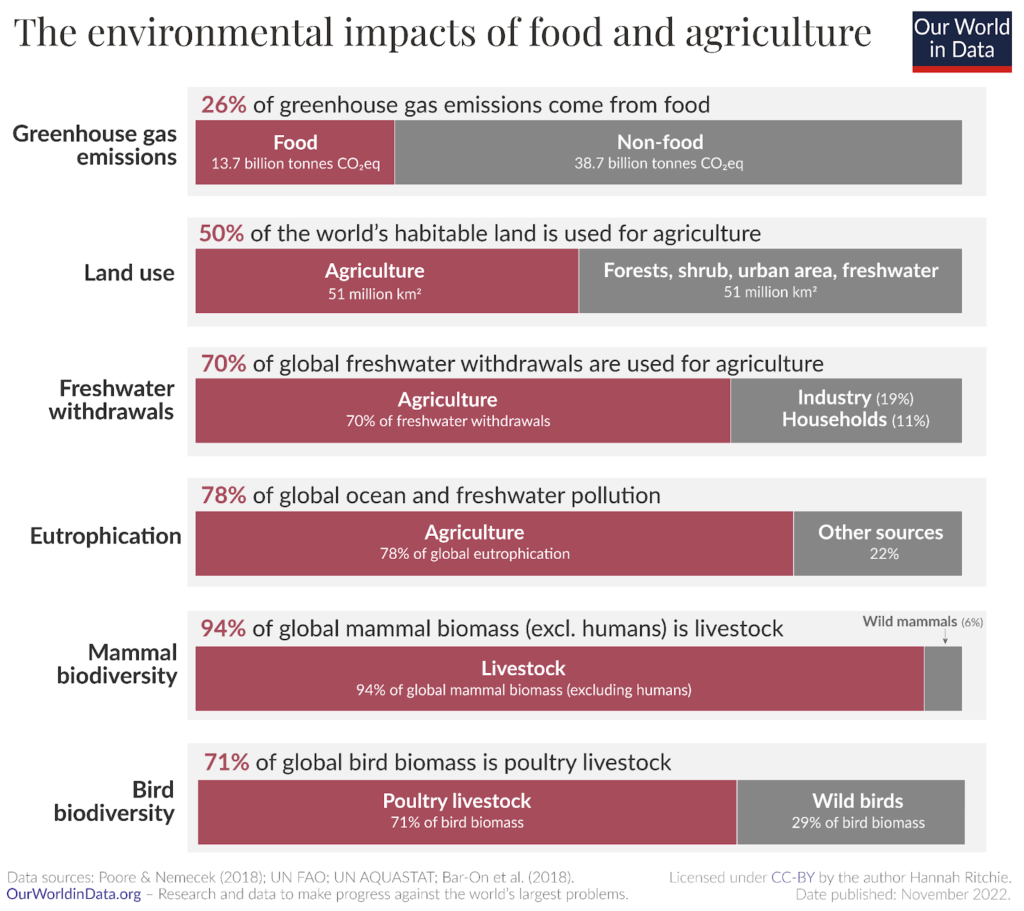
Image Source: https://ourworldindata.org/environmental-impacts-of-food/
Understanding these impacts empowers us to make more informed choices about what we eat. It’s about making conscious decisions with an awareness of how those choices ripple toward a more considerable global impact.
Adopting a plant-based diet can significantly reduce your environmental footprint and contribute to biodiversity conservation while also helping you save money in the long run.
Plant-based diets require fewer natural resources and produce fewer greenhouse gas emissions than diets high in animal products. Incorporate more fruits, vegetables, grains, and legumes into your meals, and minimize consumption of meat and dairy products. Not only is a plant-based diet better for the planet, but it can also improve your health and well-being.
5. Minimize Water Usage
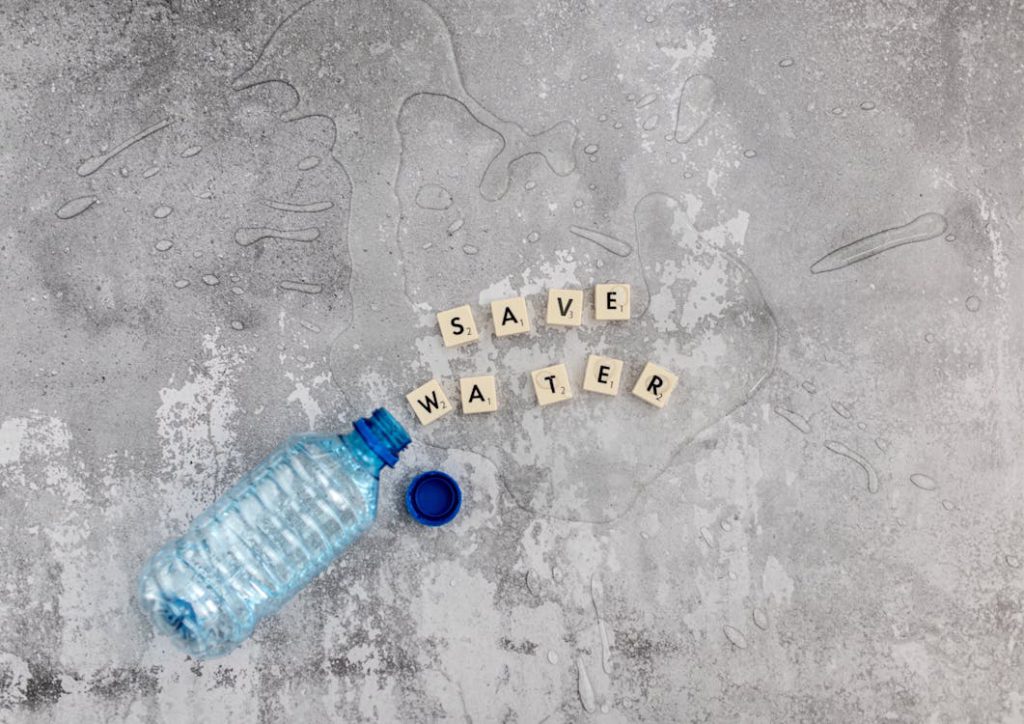
Image Source: https://www.pexels.com/photo/cubes-with-letters-and-plastic-bottle-with-spilled-water-4289045/
Freshwater is an essential yet finite resource, and it is under considerable stress due to various factors. The surge in population growth, coupled with resource-intensive economic activities, has led to increased water consumption, straining natural ecosystems. The impacts of climate change further exacerbate the situation by making water availability more unpredictable and significantly reducing terrestrial water storage, as noted by UN-Water.
Water scarcity is becoming a more pressing issue worldwide, necessitating immediate action to conserve this vital resource. Here are ways you can minimize your water footprint and contribute to water conservation efforts:
-
- Mindful Water Use: Become aware of your daily water usage habits and look for ways to reduce consumption. Taking simple actions, such as turning off the tap while brushing your teeth or shaving, can save significant amounts of water over time.
-
- Fix Leaks Promptly: A dripping faucet or leaking toilet can waste thousands of gallons of water yearly. Promptly fixing leaks is an easy way to conserve water and reduce your utility bill.
-
- Efficient Appliances: Consider investing in water-efficient appliances like washing machines and dishwashers. Look for products with a high Water Efficiency Labelling and Standards (WELS) rating or similar certifications in your country.
-
- Low-Flow Fixtures: Installing low-flow showerheads, faucets, and toilets can drastically reduce your home water usage without sacrificing performance.
-
- Water-Smart Landscaping: Opt for native plants that require less water and use mulch to retain soil moisture. When watering your garden, do so early in the morning or late in the evening to minimize evaporation.
-
- Reuse Greywater: Where possible, reuse greywater from baths, showers, and washing machines for landscaping or flushing toilets.
-
- Collect Rainwater: Set up a rainwater harvesting system to collect rainfall for use in gardening, landscaping, or even toilet flushing, where local regulations allow. This practice reduces your reliance on municipal water supply, minimizes using water from the tap, and embraces a natural water source.
-
- Advocate and Educate: Share your knowledge about water conservation with friends, family, and community members. Supporting policies that protect water resources also plays a critical role in ensuring sustainable water management.
- Support Water Conservation Projects: Whether through donations or volunteer work, support local and international projects focused on water conservation, access to clean water, and sustainable water practices.
Your Weekly Sustainability News!
By subscribing you agree to our Privacy Policy
6. Support Sustainable Fashion

Image Source: https://www.pexels.com/photo/trendy-young-asian-women-choosing-cotton-bags-in-fashion-boutique-5710151/
The fashion industry, particularly the fast fashion segment, has a significant environmental footprint and socio-economic impact. According to the Center for Biological Diversity, fast fashion operations contribute to extensive pollution and carbon dioxide emissions—up to 10% of global emissions.
Moreover, the industry’s reliance on quick production cycles with cheap materials worsens environmental degradation and exploits workers in low-income countries. These workers, often young women, face poor working conditions and receive wages below a living wage threshold, while the companies they labor for achieve high profits.
To contribute to combatting these issues and reduce your wardrobe’s environmental impact, consider these steps focused on supporting sustainable fashion:
-
- Research Brands: Look for fashion companies that are transparent about their sourcing, manufacturing processes, and labor practices. Brands committed to sustainability will typically share detailed information about their efforts to minimize environmental damage and ensure fair working conditions.
-
- Choose Quality Over Quantity: Invest in durable, timeless pieces rather than succumbing to the ever-changing trends of fast fashion. High-quality clothing lasts longer, so you’ll buy less frequently and generate less waste.
-
- Eco-Friendly Materials: Prioritize items made from sustainable or recycled materials like recycled plastic bottles and plant-based fibers. Many eco-conscious brands use organic cotton, recycled polyester, or other environmentally friendly fabrics that have a lower impact on the planet.
-
- Support Ethical Practices: By choosing brands that assure fair wages and safe working conditions for their workers, you’re contributing to positive change in the industry. Every purchase from such brands is a vote for ethical practices.
-
- Recycle and Donate: Extend the life of your clothes by donating items you no longer wear or recycling them through programs that repurpose textiles. This reduces waste and supports circular economy principles within the fashion industry.
-
- Educate Yourself and Others: Stay informed about the impacts of fast fashion and share your knowledge with friends and family. Awareness can drive more consumers towards sustainable choices, collectively influencing the industry towards better practices.
-
- Embrace Second-Hand and Vintage: Shopping for clothing at thrift stores, vintage shops, or second-hand online platforms offers the opportunity to find unique pieces and significantly reduces the demand for new production. This approach keeps clothes out of landfills and reduces the resources needed for manufacturing new items.
-
- Care for Your Clothes Properly: Extend the lifespan of your garments through proper care—washing less frequently, avoiding dry cleaning when possible, and following care instructions closely. Additionally, learning basic sewing skills to mend your clothes can enormously extend their usability and is an empowering way to be self-sufficient and sustainable. Fixing a button, sewing a patch, or darning a hole saves clothing from landfills and can drastically reduce the need for frequent replacements and the overall demand for new garments.
-
- Engage in Clothing Swaps: Participate in or organize clothing swaps with friends or within your community. This promotes a circular fashion economy, where many people reuse and enjoy clothes instead of being discarded.
-
- Minimalist Wardrobe: Consider adopting a minimalist approach to your wardrobe, focusing on versatility and personal style over quantity. A capsule wardrobe of well-chosen pieces can fulfill all your fashion needs without contributing to fast-fashion consumption.
7. Reduce Food Waste

Image Source: https://unsplash.com/photos/green-plant-on-white-and-purple-floral-ceramic-pot-FTCQPjPfFS4
According to the World Bank, 1/4 to 1/3 of global human food is lost or wasted annually. That translates to 1.3 billion tons of food lost or wasted yearly, resulting in almost $1 trillion in economic losses.
Food waste is not just a matter of excess; it’s a crisis with profound environmental and humanitarian impacts. Food production consumes vast resources—water, land, energy—and when that food is wasted, all those inputs are wasted, too. Moreover, when discarded food ends up in landfills, it decomposes anaerobically (without oxygen), producing methane, a potent greenhouse gas that exacerbates climate change.
The effects of food waste extend far beyond environmental concerns. It also contributes to global hunger of unprecedented proportions. With 783 million people battling chronic hunger, the loss of perfectly edible food is a painful paradox. The fact that 24,000 individuals die daily from hunger, as highlighted by David Beasley during the 2021 Food System Summit, underscores the urgency of tackling food waste not just as an environmental strategy but as a moral imperative.

Image Source: https://www.worldbank.org/content/dam/Worldbank/Highlights+%26+Features/Poverty/pov-food-waste-infographic-final1-web.jpg
Minimizing food waste starts at home, and it requires a multifaceted approach that you can integrate into your lifestyle:
-
- Prevention at the Source: The most effective way to tackle food waste is to prevent it from happening in the first place. That means planning meals, only buying necessary food, and being mindful of expiry dates.
-
- Efficient Food Storage: Proper storage can significantly extend the life of your food. Learning to store fruits, vegetables, dairy, and other perishables can reduce the amount going bad before consumption.
-
- Embrace ‘Ugly’ Food: Much of the food waste occurs because produce that is perfectly edible but doesn’t meet cosmetic standards is thrown away. Buying imperfect fruits and vegetables helps reduce this type of waste.
-
- Donate Excess: When possible, donate surplus food to soup kitchens, food banks, and shelters. Doing so can reduce waste and help those in need.
-
- Compost: Composting is a viable solution for unavoidable food waste like peels and scraps. Composting turns waste into valuable nutrients for the soil, diminishing the need for chemical fertilizers and reducing methane.
-
- Value Leftovers: Change perceptions about leftovers. With a bit of creativity, yesterday’s meals can be transformed into new, delicious dishes. This approach reduces waste, which is better for the environment and can inspire a more thoughtful and appreciative relationship with food.
-
- Rethink Best Before Dates: Understanding the difference between “best before” and “use by” dates can prevent premature disposal of food. Much of the food thrown away due to date labels remains safe and nutritious to eat well beyond its “best before” date.
-
- Participate in Sharing Economies: Join or initiate community-based sharing programs where excess food can be shared rather than thrown away. Platforms and apps designed to facilitate the sharing of surplus food between neighbors or within communities are also emerging.
8. Embrace Minimalism

Image Source: https://unsplash.com/photos/gray-dress-shirt-hang-on-brown-wooden-rack-in-front-of-window-with-white-curtain-QZGQO3NvsLo
The relentless drive for more possessions marks the age of consumerism and materialism in which we live. While there are undeniable benefits, such as job creation and the ability to meet basic needs, this cycle of constant consumption comes with a significant cost to our planet and society.
Christopher Flavin, President Emeritus at Worldwatch Institute, highlights a critical paradox: the very appetite for increased consumption that fuels economic growth is simultaneously eroding the natural systems we rely on, further complicating efforts to address global poverty.
In light of these challenges, embracing minimalism presents a sustainable alternative. Minimalism is not just about owning fewer things; it’s a deliberate choice to focus on what truly matters. Here are ways to integrate minimalism into your life and contribute positively to the environment:
-
- Declutter Consciously: Begin by reducing the clutter in your home. Donate, sell, or recycle items you no longer use or need. This process is about creating physical space and fostering mental clarity and appreciation for what you have.
-
- Prioritize Experiences: Shift your focus from acquiring objects to experiencing life. Valuing experiences over possessions encourages connections with family, friends, and the community, leading to richer, more fulfilling lives.
-
- Buy Quality Over Quantity: When making necessary purchases, choose items for their durability and long-term value rather than their price or trendiness. High-quality products last longer and reduce waste and the need for frequent replacements.
-
- Live Intentionally: Every purchase and decision can align with your values and the kind of world you want to support. Ask yourself if what you’re considering buying truly adds value to your life or is merely an impulse buy.
-
- Embrace DIY and Skills Development: Learning to repair, create, or grow things independently reduces dependency on buying new products and enriches your skill set. Whether fixing a leaky faucet, knitting a scarf, or cultivating a garden in your apartment, these skills promote a more sustainable lifestyle and provide a sense of satisfaction.
-
- Adopt a Capsule Wardrobe: This concept involves curating a limited selection of versatile clothes you love to wear, reducing the need for excessive clothing. A capsule wardrobe simplifies daily decisions, clears closet clutter, and counters the fast-fashion cycle.
-
- Support Sustainable Brands: When purchases are necessary, choose brands committed to ethical and eco-friendly practices. Supporting businesses prioritizing sustainability over profit margins amplifies the demand for responsible production and consumption.
-
- Mindful Technology Use: In our digital age, gadget consumerism is rampant. Resist the urge to upgrade electronics frequently. Use devices as long as they function well, and recycle electronics responsibly at the end of their life cycle.
-
- Reduce Digital Clutter: Minimalism extends to the digital realm, too. Regularly declutter your digital spaces, such as email inboxes, social media feeds, and files. This can improve mental focus and reduce the environmental impact associated with digital storage.
-
- Simplify Your Meals: Adopting a minimalist approach to eating—focusing on whole foods and reducing processed goods—can benefit your health and the planet. Planning meals helps minimize food waste, another critical aspect of living sustainably.
-
- Educate Yourself and Others: The journey towards minimalism is ongoing and evolves with awareness. Share insights and learn from communities dedicated to sustainable living. Education fosters a collective shift toward minimalism, amplifying its positive impact on our world.
9. Cultivate Sustainable Habits
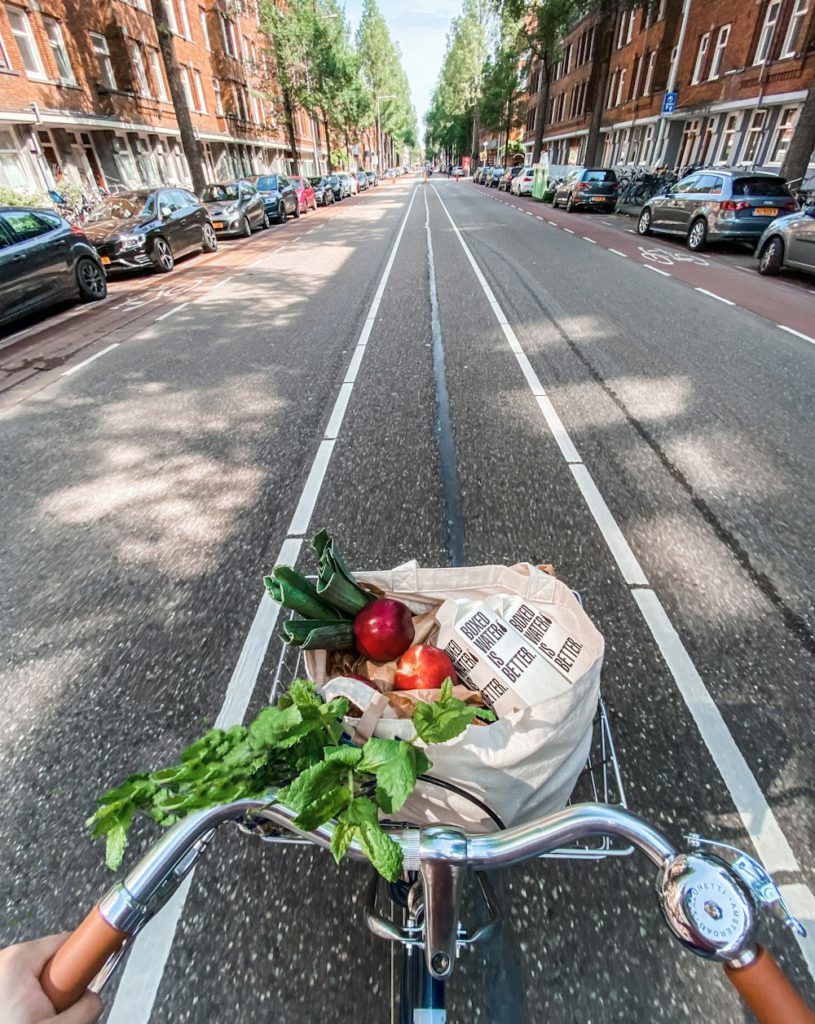
Image Source: https://unsplash.com/photos/red-roses-in-brown-cardboard-box-on-bicycle-6WrKKQcEnXk
Sustainability goes beyond individual actions; it embodies a more profound stewardship philosophy and a collective commitment to safeguard our planet for future generations. It involves recognizing our connection with the environment and understanding that every decision and action we take affects the ecological web.
Cultivating a sustainability mindset means seeing ourselves as caretakers of the Earth, responsible for its well-being. It’s about moving beyond short-term gains and considering the long-term health of our planet. Here are ways to foster this mindset of stewardship and responsibility:
-
- Educate Yourself: Knowledge is power. Understanding the science behind sustainability issues, from climate change to biodiversity loss, empowers you to make informed decisions. Books, documentaries, online courses, and reputable news sources can be excellent resources.
-
- Reflect on Your Impact: Consider how your lifestyle contributes to environmental challenges. This reflection isn’t about inducing guilt but inspiring actionable change towards more sustainable practices in daily life.
-
- Set Sustainable Goals: Whether reducing plastic use, lowering your carbon footprint, or advocating for clean energy, setting clear goals can guide your journey toward sustainability. These goals can evolve as you learn and grow in your understanding.
-
- Embrace Mindful Consumption: Before making purchases, think about their necessity, their environmental impact, and their contribution to overconsumption culture. Opting for quality over quantity and supporting eco-friendly businesses are ways to practice mindful consumption.
-
- Advocate for Environmental Policies: Individual actions are vital, but systemic change is crucial for meaningful environmental protection. Support policies that promote local, national, and global sustainability by voting, attending town meetings, or writing to your representatives.
-
- Foster Community Action: Sustainability efforts can be more impactful when communities unite. Participating in or organizing local clean-up drives, tree-planting events, recycling programs, or educational workshops can enhance community bonds and collectively contribute to sustainability efforts. Sharing knowledge and resources within your community fosters a culture of stewardship that can influence broader societal change.
-
- Normalize Eco-Friendly Habits: By integrating eco-friendly practices into your daily life and openly discussing them with friends, family, and colleagues, you help normalize these behaviors. When sustainable living becomes a societal norm rather than an exception, it can lead to broader adoption of environmentally responsible habits.
-
- Leverage Social Media for Awareness: Social media is a powerful tool for raising awareness about sustainability issues and solutions. By sharing relevant information, success stories, and practical tips for living sustainably, you can inspire others to take action and spread the message further.
-
- Practice Resilience and Adaptability: The journey toward sustainability is ongoing and often requires adapting to new information, challenges, and technologies. Staying informed and being open to change is crucial for navigating this evolving landscape effectively.
-
- Support Sustainable Innovations: Encourage and support innovations in clean energy, sustainable agriculture, waste reduction, and other areas critical to achieving sustainability goals. This can involve investing in sustainable startups, purchasing innovative eco-friendly products, or spreading the word about promising technologies.
10. Practice Gratitude and Connection with Nature

Image Souce: https://unsplash.com/photos/woman-in-white-t-shirt-and-blue-denim-shorts-standing-under-green-tree-during-daytime-QJEQJLOaTOY
Practicing gratitude and deep connection with nature is essential for nurturing a sustainable mindset. The natural world offers us abundant beauty, resources, and lessons on resilience and interconnectedness. Taking the time to appreciate these gifts can enhance our desire to protect and preserve our environment.
Here are some ways to deepen your gratitude and connection with nature:
-
- Spend Time Outdoors: Make a conscious effort to spend more time in natural settings. Whether it’s a walk in the park, eco-camping, or simply sitting by a lake, being outdoors helps you appreciate the beauty and complexity of the natural world.
-
- Observe Mindfully: Practice mindfulness while in nature. Pay attention to the details—the colors of a sunset, the patterns on leaves, the sounds of birds. Mindful observation can lead to a greater appreciation of nature’s wonders.
-
- Learn About Local Flora and Fauna: Gain knowledge about the plants and animals in your area. Understanding their roles in your local ecosystem can deepen your appreciation for their existence and the delicate balance of nature.
-
- Participate in Conservation Efforts: Engage in activities that preserve natural habitats, such as tree planting, clean-up campaigns, or wildlife protection initiatives. Contributing to the planet’s health fosters a sense of responsibility and gratitude.
-
- Practice Eco-therapy: Incorporate elements of eco-therapy into your life, such as gardening, forest bathing (Shinrin-yoku), or animal-assisted therapy. These practices improve mental well-being and foster a strong connection with nature.
-
- Keep a Gratitude Journal: Regularly jot down the aspects of nature you are grateful for. Consider the food that sustains you, the water that hydrates you, and the air that fills your lungs. Acknowledging these daily gifts cultivates ongoing gratitude and inspires continued commitment to environmental stewardship.
-
- Educate Yourself About Indigenous Practices: For centuries, many Indigenous cultures have maintained a deep respect and connection with the earth. Learning about their practices and perspectives can offer valuable insights into living harmoniously with nature. Indigenous wisdom often emphasizes the sacredness of all living beings and the importance of balance and reciprocity with the earth.
-
- Support Nature Education: Advocate for and support educational programs on nature and environmental stewardship. Education is crucial in shaping attitudes towards nature and can foster a sense of responsibility early on.
-
- Participate in Citizen Science Projects: Engage in citizen science projects ranging from bird counting to monitoring local water quality. These projects contribute to scientific knowledge and deepen your understanding and appreciation of nature.
What Eco-Friendly Lifestyle Means to You and the Environment
Living an eco-friendly lifestyle has profound implications for the environment. This way of living directly contributes to reducing waste and pollution, conserving natural habitats, safeguarding endangered species, and restoring balance to ecosystems.
Extending well beyond the noble act of protecting the environment, adopting an eco-friendly lifestyle brings a myriad of advantages to your personal life. By intentionally reducing consumption, cutting down waste, and leaning towards sustainable living choices, you set the stage for a healthier, more cost-effective, and enriched quality of life
| Benefits of Eco-Friendly Lifestyle | To the Environment | To You |
|---|---|---|
| Reduced Carbon Emissions | Minimizes greenhouse gas emissions, mitigating climate change impacts and preserving ecosystems. | Saves money on utility bills and reduces health risks associated with air pollution. |
| Conservation of Natural Resources | Preserves biodiversity, protects habitats, and reduces the strain on finite resources such as water, forests, and minerals. | Saves money by reducing consumption and waste while promoting sustainable resource management. |
| Improved Air and Water Quality | Reduces transportation, industry, and agriculture pollution, leading to cleaner air and waterways. | Reduces exposure to harmful pollutants and toxins, improving respiratory health and overall well-being. |
| Protection of Ecosystem Services | Supports essential ecological functions such as pollination, soil fertility, and nutrient cycling, which are vital for human well-being and food security. | Enhances quality of life by ensuring access to clean air, water, food, and recreational opportunities in natural environments. |
| Climate Resilience and Adaptation | Builds resilience to climate change impacts such as extreme weather events, sea-level rise, and habitat loss, ensuring the long-term viability of ecosystems and communities. | Promotes mental well-being and resilience by fostering connections with nature and providing opportunities for outdoor recreation. |
| Sense of Purpose and Fulfillment | Empowers individuals to align their values with their actions, fostering a sense of meaning and contribution to positive social and environmental change. | Cultivates a sense of fulfillment and satisfaction through participation in community initiatives and advocacy for sustainability. |
Conclusion
Every day, we make choices that directly impact the environment. Hence, the choice to upgrade to an eco-friendly lifestyle is essential for addressing the nature crisis and creating a more sustainable and equitable world for future generations.
By implementing the smart strategies outlined above and embracing a sustainability mindset, you can make a meaningful contribution to protecting the planet and ensuring a brighter future for all life on Earth.
Take action today and be the change you wish to see in the world!
Frequently Asked Questions
What does it mean to live a more sustainable lifestyle?
Living a more sustainable lifestyle means making conscious choices to reduce your impact on the environment by minimizing waste and living in a way that is better for the planet.
What are some sustainable living tips for beginners?
Some sustainable living tips for beginners include using public transport, reducing energy consumption by unplugging devices, and opting for glass containers over plastic ones for storage.
How can I reduce my carbon footprint?
You can reduce your carbon footprint by making small changes such as taking shorter showers, supporting renewable energy providers, and being conscious of your grocery shopping habits.
What impact does fast fashion have on the environment?
Fast fashion contributes to enormous CO2 emissions, water pollution, and waste. By opting for sustainable and ethical fashion choices, we can help mitigate its negative impact.
Why is it important to donate rather than discard unwanted items?
Donating unwanted items rather than discarding them helps reduce waste and gives these items a second life, ultimately contributing to a more sustainable and circular economy.
How can sustainable living actually save you money?
Sustainable living practices such as reducing energy consumption and opting for reusable items can save you money in the long run by lowering utility bills and decreasing the need for frequent replacements of disposable items.
What are some simple steps to make sustainable living a part of daily life?
Simple steps like using reusable shopping bags, supporting sustainable brands, and being mindful of water and electricity usage can all make sustainable living a seamless part of daily life.
Why is it important to consider the environmental impact when making purchases?
Considering the environmental impact of purchases helps reduce the demand for products that harm the environment and instead supports the market for more sustainable and eco-friendly options.


